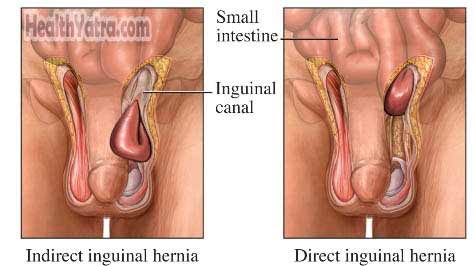Definition
A groin hernia occurs when abdominal tissue or fat pokes out through the abdominal wall. It causes a bulge in the groin area. There are two main types:
- Inguinal hernia—occurs in the area where the abdomen meets the thigh on both sides. This is the most common type.
- Femoral hernia—located in the upper thigh.
A hernia can trap a section of intestine, leading to blockage or problems with blood flow. This is a medical emergency and requires immediate care.

Causes
The abdominal wall wraps around your middle from the bottom of your ribs to your pelvis. It helps to contain and support your abdominal organs and tissue. When this area is weakened these internal tissues can press through can create the hernia. The weakness may be caused by a problem with the abdominal wall development before birth, injuries, or wear and tear of the muscles.
Risk Factors
Groin hernias are more common in men and femoral hernias are more common in women.
Factors that increase your chance of abdominal wall weakness include:
- Obesity
- Advancing age
- Wear and tear on abdominal wall from frequent lifting of heavy objects, or prolonged coughing or straining
- Previous surgery in the abdominal area
Symptoms
Many times, there are no symptoms with groin hernia. In those that do have them, the symptoms may include:
- A bulge in the groin area when standing or straining
- Pain in the groin area when straining
- A bulge that may extend into the scrotum
- Pain and/or a heavy feeling or discomfort in the groin area
More serious symptoms may need emergency care:
- Severe pain in the groin or abdomen
- Fever
- Abdominal swelling
- Nausea
- Vomiting
Diagnosis
The doctor will ask about your symptoms and medical history. A physical exam will be done. Imaging studies are only done if the diagnosis in not clear by physical exam.
Treatment
Watchful waiting is an option for those with no symptoms. This means you and your doctor will monitor your hernia for growth or the appearance of more serious symptoms. In people with symptoms, hernias are repaired with surgery. The abdominal tissue will be pushed back in and the opening will be closed. Sometimes a mesh material will be placed to help support the area.
Prevention
The following strategies may help to prevent a groin hernia:
- If you are overweight, lose weight.
- Exercise regularly to keep abdominal muscles strong.
- Learn to lift properly. Ask for help with heavy weights.
- Stop smoking, especially if you have a chronic cough.
